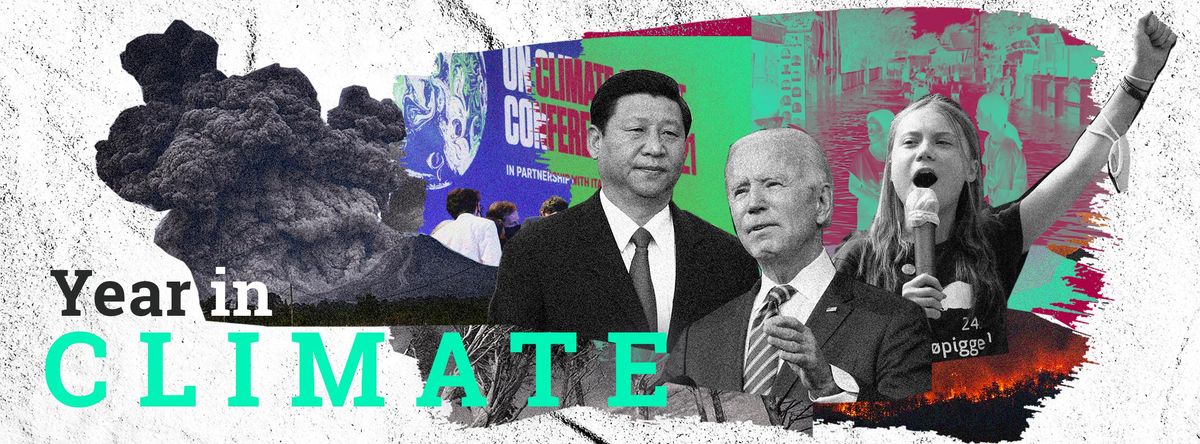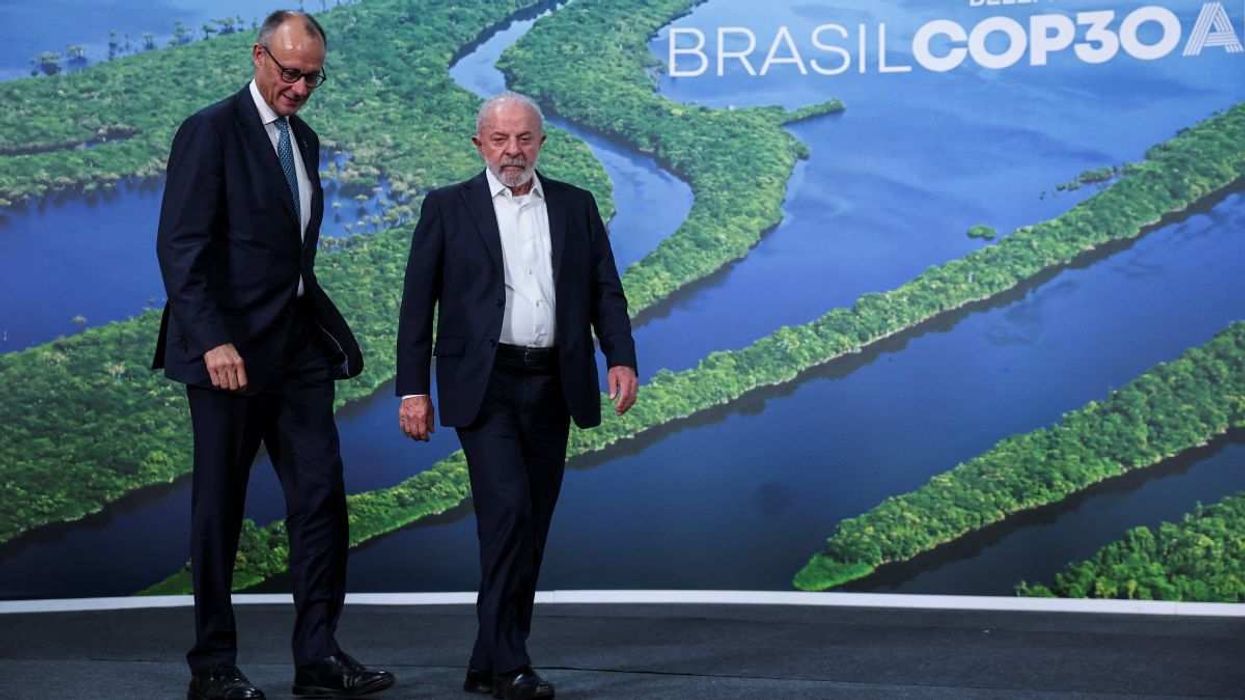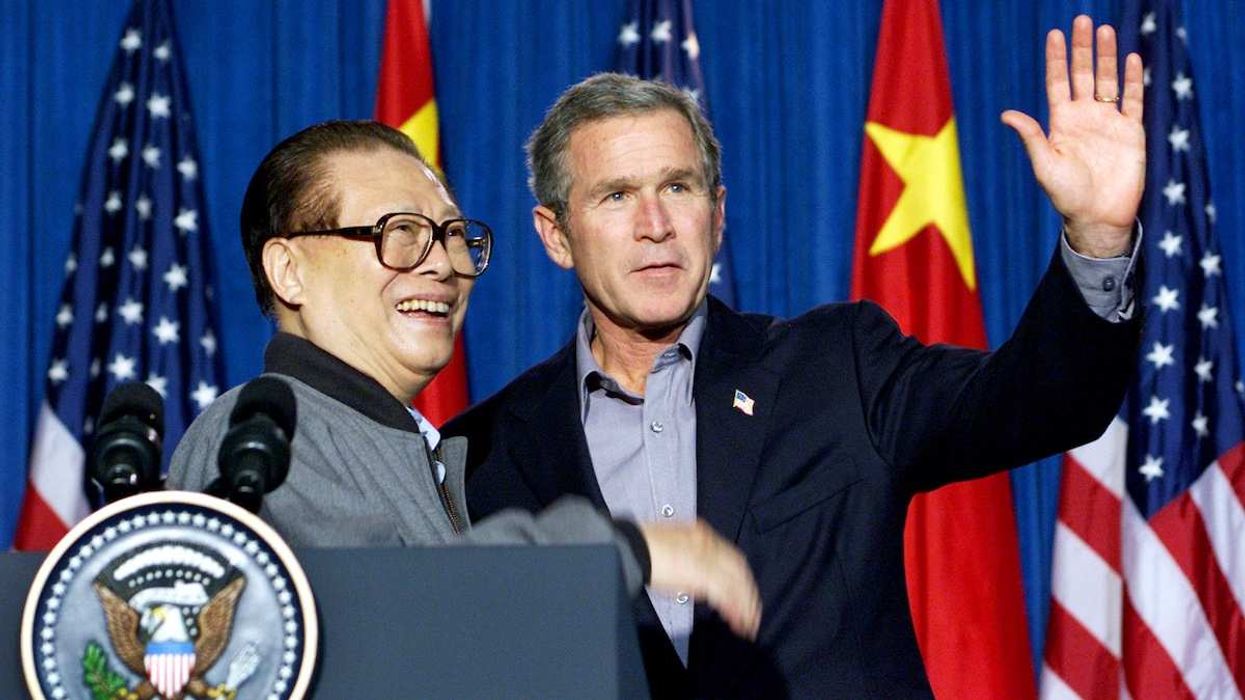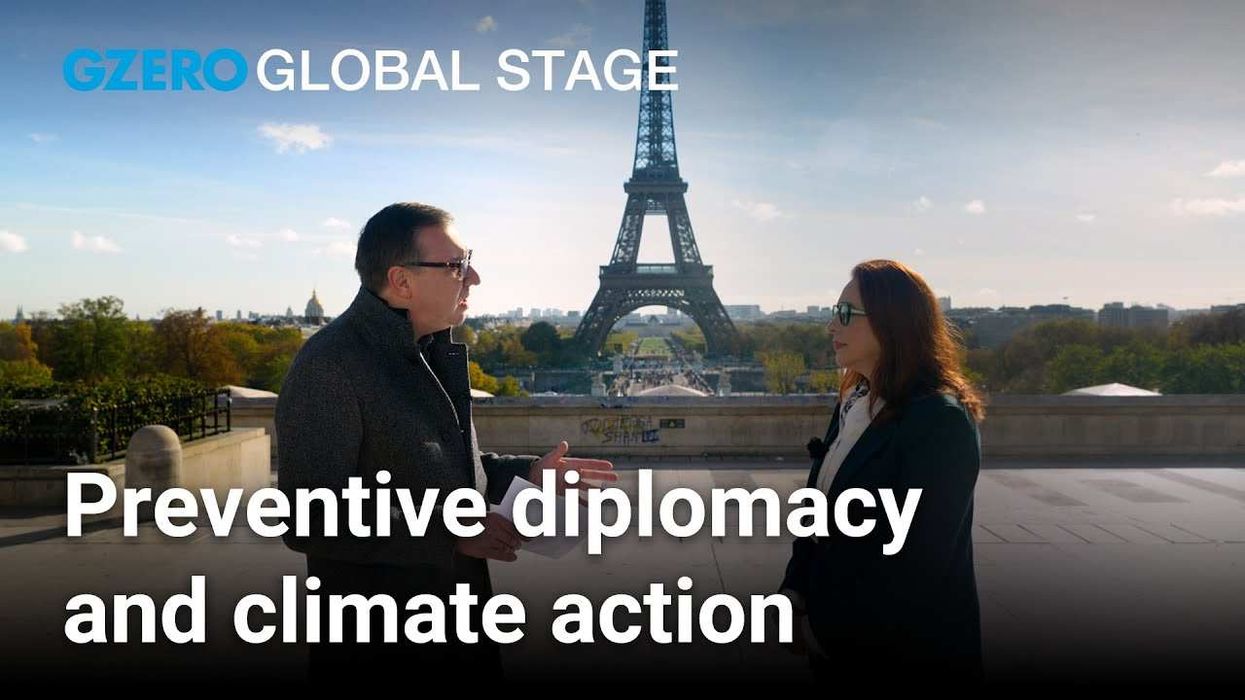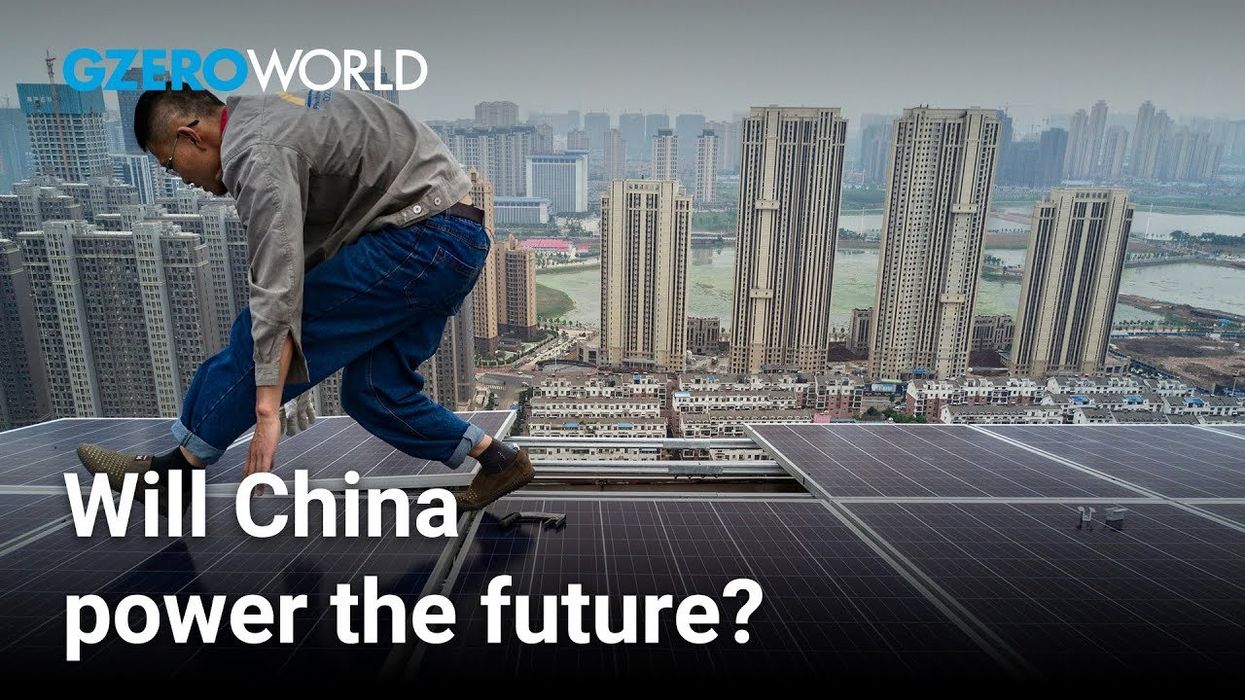Want to understand the world a little better? Subscribe to GZERO World with Ian Bremmer for free and get new posts delivered to your inbox every week.
Like this newsletter? Share it with others you think would enjoy it, too.
As 2022 nears and 2021 ends, a zillion retrospectives on the past year will start competing for your attention. This is the best one.
Or the first of the best several. As I’ll be posting a bunch of these in the next two weeks, starting today with a review of the most significant climate change news to come out of 2021. (I know, you expected a list of The Best Taylor Swift Songs of the Year. Sorry to disappoint.)
As it turns out, it was a big year for climate, with lots of good and not-so-good developments. Without further ado…
Here’s the glass half full
1. Six degrees of global warming are off the table: Even under the most pessimistic of scenarios, namely business-as-usual, the world is now projected to warm by less than 4°C—and likely under 3°C—by 2100 relative to preindustrial levels. That’s a far cry from the 1.5°C threshold agreed to in Paris, but it also means we won’t make the planet unlivable (for humans, at least). We may take this progress for granted, but it was only a few years ago that 5-6°C—with the existential risks that warming entailed—was a plausible scenario.
2. Renewables kept getting cheaper: The cost of renewable energy continued to fall rapidly, making it increasingly competitive with, and even cheaper than, fossil fuels. Technological progress has made it possible for profit and national gains, rather than political will and global solidarity, to drive decarbonization. The domestic politics of climate action in countries like the US still have to catch up with this reality, but the economics are settled: the transition to net-zero can be a win-win (provided that losers are compensated).
3. The private sector is pulling the cart: Corporations, the financial sector, and the investment community have seen the future, and it is green. In 2021, more than 450 financial institutions from 45 countries managing $130 trillion in assets committed to aligning their investments with net-zero emissions by 2050. These institutions are part of the Glasgow Financial Alliance for Net Zero, whose membership has grown more than 25-fold this year. The COP26 summit also saw a flurry of business pledges as part of the Race to Zero campaign. All this momentum translates into a self-reinforcing cycle of increased demand for green technologies, higher investment, lower prices, at-scale adoption, and unlocked possibilities. Even in the absence of strong government policy signals, courtesy of the G-Zero order, a private sector that increasingly recognizes that getting out in front of climate change isn’t just right but also profitable will drive continued climate progress.
4. America is back(-ish): After four years of denier-in-chief Donald Trump, climate change is back as a policy priority for the world’s largest historical emitter, both domestically and abroad. On the global stage, President Biden rejoined the Paris Agreement and is trying to take on a global climate leadership role, having convened several high-level summits through the year to boost international cooperation and pressure other leaders to increase their efforts. At home, Biden adopted more ambitious targets and signed a historic $1.2 trillion infrastructure bill that contains the nation’s largest-ever investment in clean energy, green infrastructure, and climate resilience.
5. Major emitters raised their emissions reduction ambitions: Countries responsible for more than 90% of global emissions submitted new targets and long-term goals. Most notably, the US announced a strengthened target of reducing emissions by 50-52% below 2005 levels by 2030. The EU agreed to a stronger 2030 emissions target of at least 55% net reduction below 1990 levels. China committed to net-zero emissions before 2060 and to peaking carbon dioxide emissions before 2030. And India proposed a 2070 net-zero target and committed to reducing emissions by 1 billion tonnes by 2030. All in all, if countries implemented all their announced targets in full, the world would be on track for 1.8°C of warming.
6. Methane is on its way out: While shorter-lived than carbon dioxide, methane is over 30 times more powerful than CO2 at warming the planet over a century. In 2021, more than 100 countries—including the US, the EU, and Japan—accounting for half of global methane emissions signed on to the Global Methane Pledge and committed to cutting their methane emissions by 30% by 2030. While it didn’t commit to a timetable or hard target, China also pledged for the first time ever to reduce its methane emissions
7. A win for trees: At COP26, more than 130 countries—including Russia, Brazil, the US, Colombia, and Congo—home to 85% of the world’s forests promised to end and reverse net deforestation by 2030, in an effort to preserve the planet’s largest natural carbon sinks and slow down climate change. Governments and corporations backed the pledge with $19 billion and a commitment to divest from activities that destroy forests. Back in January, Biden had announced that the US would aim to conserve at least 30% of its land and water by 2030, and in the April climate leader summit, a coalition of governments (including the US, the UK, and Norway) and companies committed to paying countries that show they’re preventing deforestation.
8. Climate finance gets a test run: In the opening days of COP26, the US, the UK, France, Germany, and the EU announced a deal to help South Africa finance its transition away from coal and towards renewables. The $8.5 billion package of grants and concessional finance could offer a model for the rich world to help other developing economies phase out fossil fuels.
9. The end of coal and fossil fuel subsidies is in sight: Coal burning is responsible for about one-third of global carbon emissions. In 2021, 25 countries including China, Japan, and South Korea pledged to stop financing coal-fired power abroad, and more than 40 countries—including 5 of the top 20 coal producers but excluding China, India, and the US—promised to end coal use at home by 2030 (for major economies) or 2040 (globally). While China did not commit to a timetable, it did pledge to accelerate its phasedown of coal consumption. Moreover, the Glasgow Climate Pact (the consensus document agreed to by all COP26 parties) called for countries to phase down “unabated coal power and inefficient fossil fuel subsidies.” This is the first time a global climate agreement explicitly mentions ‘fossil fuels’ and calls for their eventual demise.
10. The Paris puzzle is finally complete: Since the Paris climate accord was signed in 2015, countries had been unable to agree on rules to determine how they can trade emissions credits with each other to meet their climate targets. In Glasgow, negotiators finally reached an elusive deal on carbon market regulations. The new rules operationalize one of the thorniest and most important levers of the Paris Agreement.
11. The Glasgow Climate Pact upped the ante: The consensus deal, agreed to after negotiations extended into overtime, sends a strong signal that all countries need to do much more and sets up enhanced mechanisms to keep 1.5°C within reach. In addition to the new language about coal and fossil fuel subsidies and to the Article 6 agreement, the document recognized the scientific consensus about climate change and asked nations to “revisit and enhance” 2030 targets by the end of 2022 instead of waiting until 2025, an implicit recognition of the urgency of faster action and greater accountability.
Here’s the glass half empty
1. 2020 was a blip: The concentration of carbon dioxide in the atmosphere reached a record high this year, dashing hopes that last year’s dip in emissions due to the Covid-19 pandemic would persist. Global warming is already estimated to be at 1.2°C above preindustrial levels.
2. We’re not on track for 1.5°C of warming: For all the breakthroughs and the change in policy trajectory, the world is on pace to miss the 1.5°C goal countries committed to in Paris. The collective failure to live up to the Paris ambition is due to two outstanding gaps: an ambition gap and an action gap. First, the world did not announce or pledge big enough emissions reductions to limit global warming to the Paris goal of 1.5°C. If all countries fully implemented their pledges, targets, and long-term announcements (a big if), the planet would still be likely to warm by 1.8°C by 2100. Second, the record shows that actual policies have consistently fallen short of promises. Nations have repeatedly failed to meet their climate pledges, with current policies putting the world on pace for 2.7°C of warming by the end of the century. To keep 1.5°C within reach, countries need to both aim higher and do more to meet their goals.
3. Climate ambition is no match for domestic politics: Biden’s policy preferences notwithstanding, the US has limited capacity to credibly commit to and implement the president’s agenda in the face of a divided Congress, a Democratic swing senator that opposes much of it, and an unfavorable electoral environment in 2022 and possibly 2024. Despite his win on infrastructure, Biden wasn’t able to secure legislation for new regulatory tools like a clean energy standard, and a 6-3 conservative Supreme Court will limit all executive and regulatory efforts—to say nothing of what would happen if and when Republicans retake the House, the Senate, and/or the White House. The consistent inconsistency of US climate policy continues to undermine Biden’s attempts to credibly commit the country to net zero and to lead globally on climate.
4. Short-term energy needs have primacy over long-term climate goals: It was a tough year for consistency. At the same time as they were talking a big game in Glasgow, industrialized countries were making moves to secure reliable and affordable access to fossil fuels and ensure their citizens wouldn’t freeze this winter. Rampant shortages and soaring prices of oil, gas, and coal—only partially explained by an incipient transition towards renewables—had America asking OPEC+ to increase oil production, the EU at the mercy of Russian gas exports, and China expanding domestic coal production. Not a good look, but an inevitable one in a world of competing pressures. The problem is much more pronounced for most developing countries in earlier phases of economic development, for whom energy needs are growing and affordable access to power—let alone clean power—is still a significant challenge.
The world likely will generate more electricity from the dirtiest source this year than ever before, indicating just how far the energy transition still needs to run in the fight against climate change https://t.co/BpvWoc7MUe
— Bloomberg CityLab (@CityLab) December 17, 2021
5. Net-zero meets G-Zero: At Glasgow, developed nations had a chance to accelerate global climate action by bridging their long-standing differences with developing countries over burden-sharing and equity gaps. They didn’t. Rich countries failed to deliver the $100 billion in climate finance per year they had promised developing countries in 2010 to help them decarbonize (and they are not likely to do so until 2023). They failed to scale up resource transfers and technical support to help make them resilient to future climate change impacts. And they refused to compensate poor and vulnerable nations for the losses and damages they are already incurring from the impacts of global warming they didn’t cause. Rich countries’ failure to step up is not only terribly unfair but also dangerous for the world, as some developing countries like India and Brazil have warned that their willingness and ability to meet their emissions reduction targets is contingent on getting the support they are owed. Just like the absence of leadership on the global Covid-19 response prolongs and worsens the pandemic, the absence of leadership on climate finance pushes 1.5°C further out of reach.
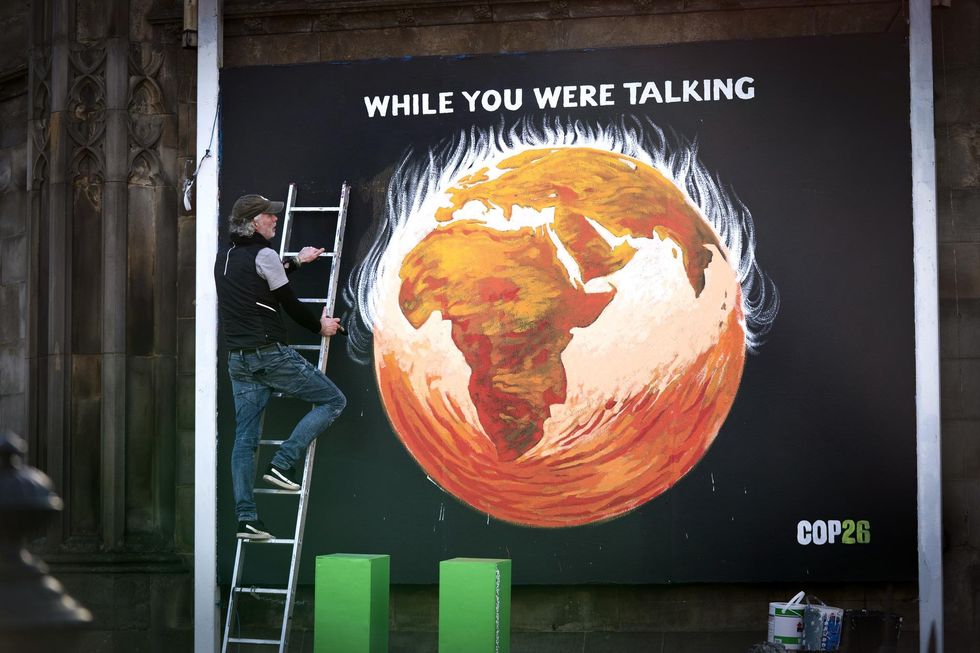 Justice and Peace artist Greg Mitchell completes his climate-crisis themed mural in Edinburgh.Jane Barlow/PA Images via Getty Images
Justice and Peace artist Greg Mitchell completes his climate-crisis themed mural in Edinburgh.Jane Barlow/PA Images via Getty Images
And here’s the bottom line
As far as I’m concerned, we end 2021 in a better place than we started it. Not because emissions went down—they didn’t. Nor because new pledges and targets put us on track for less global warming than before—they do if implemented, but that’s a massive if.
I’m increasingly optimistic because I sense we reached a tipping point this year where in spite of the absence of global leadership, momentum for action on climate change has finally passed the point of global resistance.
This is thanks not to the world’s most powerful governments, which are constrained by inescapable G-Zero realities, but to an increasingly influential global community for climate action made up of smaller countries, cities, corporations, financial institutions, multilateral organizations, NGOs, and young people.
G-Zero or not, there’s now broad consensus on the science, global recognition of the consequences of business-as-usual, and sufficient technological breakthroughs and capital deployment to ensure that the world will effectively transition away from fossil fuels in the coming decades. The question is no longer whether the transition can or should be done, but rather how quickly we can do so, how disruptive it will be, and how we manage and share its upfront costs and long-term benefits.
To be sure, there are enormous challenges ahead. Government inaction, lack of global coordination, distributional issues, and fossil fuel investment will continue to slow down progress for years, maybe decades. The last 50 years of indifference have baked in changes that have already caused and will continue to cause tremendous hardship and suffering.
But the existential question—can a growing human population survive and thrive on a planet with finite natural resources and vast but limited ecological and environmental boundaries?—is no longer an open one. That makes 2021 a great year for climate action.
Finally, some links
1. Things to watch:
- Climate crisis: Is net zero really possible?
- Surviving a warming planet
- Can we fix the planet the same way we broke it?
2. Things to read:
- Was COP26 a success or a failure?
- Climate justice: An ethical dilemma of existential proportions
- Failure to act on vaccine equity, climate is “suicide” for the world, warns UN chief
3. Things to listen to:
- Can private companies lead the way on climate action?
- Why biodiversity loss matters to governments and investors
------------
I want to hear from you. Please share your questions and thoughts in the comments section below.
And if you haven't already, don't forget to subscribe to my free newsletter, GZERO World with Ian Bremmer, to get new posts delivered to your inbox.
